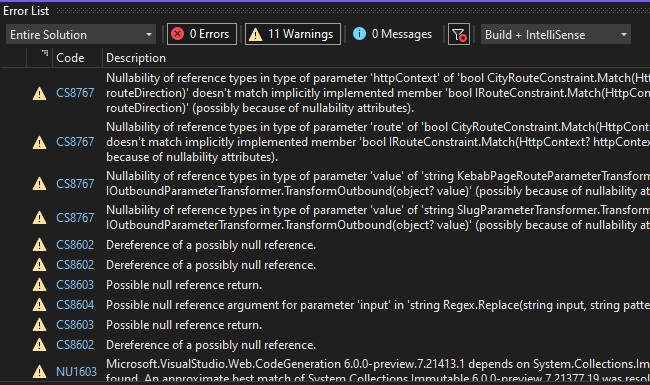The ASP.NET Core templates have been updated to use the latest C# language features, and a new minimal hosting API in .NET 6. The main driver behind these changes is simplicity. The ASP.NET team want to remove unnecessary code from your app, so you have less code to understand and look after, and there is a lower barrier to entry for newer C# developers. They want to provide "a more focused, low ceremony way of creating a web application".
In a .NET 6 app, your services and middleware configuration take place in the Program.cs file instead
of being delegated to a separate Startup class with its constructor, ConfigureServices
and Configure methods. Here's what the revised version of
Program.cs looks like:
var builder = WebApplication.CreateBuilder(args); // Add services to the container. builder.Services.AddRazorPages(); var app = builder.Build(); // Configure the HTTP request pipeline. if (!app.Environment.IsDevelopment()) { app.UseExceptionHandler("/Error"); app.UseHsts(); } app.UseHttpsRedirection(); app.UseStaticFiles(); app.UseRouting(); app.UseAuthorization(); app.MapRazorPages(); app.Run();
The first thing to notice is that the Main method is missing. This is still, after all, a console app at heart. As of C# 9, introduced last year, the
Main method is no longer necessary. Instead, this file utilises a feature called
top level statements, where the namespace, class declaration and Main methods are generated by the compiler. You just start writing executable code, which the compiler places within the generated Main method.
In .NET 5, the Program class includes a large number of using
directives,
whether they were needed or not. This version doesn't have a single one. C# 10
introduces a new feature called global usings, where a
pre-defined selection of
using directives are registered globally and are no longer required
in individual class files. The selection includes all the namespaces that you
tend to see at the top of every class file in an ASP.NET Core web app, so this
new feature greatly reduces the boilerplate noise in your code base.
Looking at the code itself, it does exactly the same thing as the Startup
class in .NET 5 and earlier. The code registers services and builds a pipeline.
But this is a lot simpler. It makes use of the new minimal hosting API, based
around the new WebApplicationBuilder type through which you configure your
app. The WebApplicationBuilder type has a number of properties that help to
simplify service registration and configuration:
Environment- provides access to theIWebHostEnvironmentServices- theIServiceCollectionthat is injected intoConfigureServicesin previous versionsConfiguration- representing among other things, theIConfigurationinjected into the olderStartupclass constructorLogging- enabling logging configuration via theILoggingBuilderHost- anIHostBuilderthat enables configuration of host specific services including third party DI containersWebHost- theIWebHostBuilderrepresented bywebBuilderparameter in theConfigureWebHostDefaultsmethod in the .NET 3.1/5 version of Program.cs
Services are added to the Services property. The project template shows how
Razor Pages is configured:
var builder = WebApplication.CreateBuilder(args); // Add services to the container. builder.Services.AddRazorPages();
You use the Configuration property to access the IConfiguration for
the app,
so that you can access connection strings and so on:
builder.Services.AddDbContext<MyContext>(options => { options.UseSqlServer(builder.Configuration.GetConnectionString("MyContext")); });
The Build method on the WebApplicationBuilder type
returns a configured application as a WebApplication type, which is
new. The
WebApplication represents a merger of the IApplicationBuilder,
IEndpointRouteBuilder and IHost
interfaces which we are familiar with from current versions of ASP.NET Core. You can use your existing extension
methods on IApplicationBuilder to build your pipeline -
UseStaticFiles, UseRouting and so on. And because it
implements IEndpointRouteBuilder, no more lambdas required to call
MapRazorPages (or MapControllers etc). You can call that directly on the
WebApplication
instead.
So the big question is: do you need to update your startup code if you migrate your .NET 5 Razor Pages app to take advantage of the long term support provided by .NET 6? The answer is No. The two-file, generic host approach to app configuration is still supported. However, if you are in the middle of writing a book about Razor Pages which is scheduled to be published after .NET 6 is released, you might just have to redo all the code samples and update the nine chapters written so far to reflect the new way of doing things...
Speaking of which, my new book Razor Pages in Action is available to purchase in MEAP now, which gives you access to chapters as they are written (and amended). You can get 35% off the price of the book (along with all other Manning products) by quoting discount code au35bri when you make your purchase. You get the full version of the book when it is finally published in the first half of next year.
Final note - there are two new settings in the csproj file that determine how
new C# features are applied to your app - ImplicitUsings and
Nullable. The first determines whether implicit, or global usings
are enabled for the project (default is enabled). The second,
Nullable, enables you to opt in to
Nullable Reference Types which was introduced in C# 8 to help you avoid the dreaded
NullReferenceException at runtime. The default is also
enabled. The main consequence of this is that your project could end up with a
lot of new warnings:

Summary
Web app configuration in .NET 6 has been simplified to a single file to
reduce the concept count for developers approaching .NET for the first time. Two
new types are introduced - the WebApplicationBuilder and the
WebApplication. You don't need to use this pattern. The existing way of
doing things that make use of a Startup class is still supported. The new
project templates also embrace a number of newer C# features.
